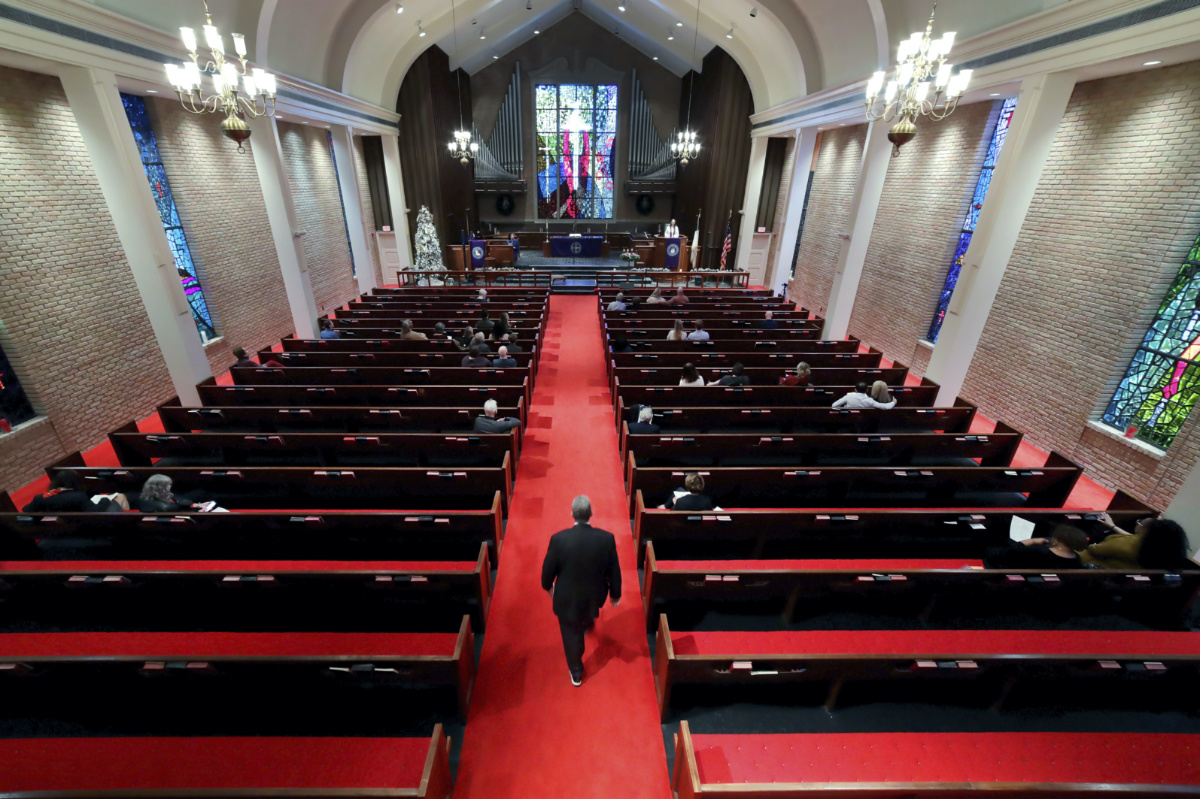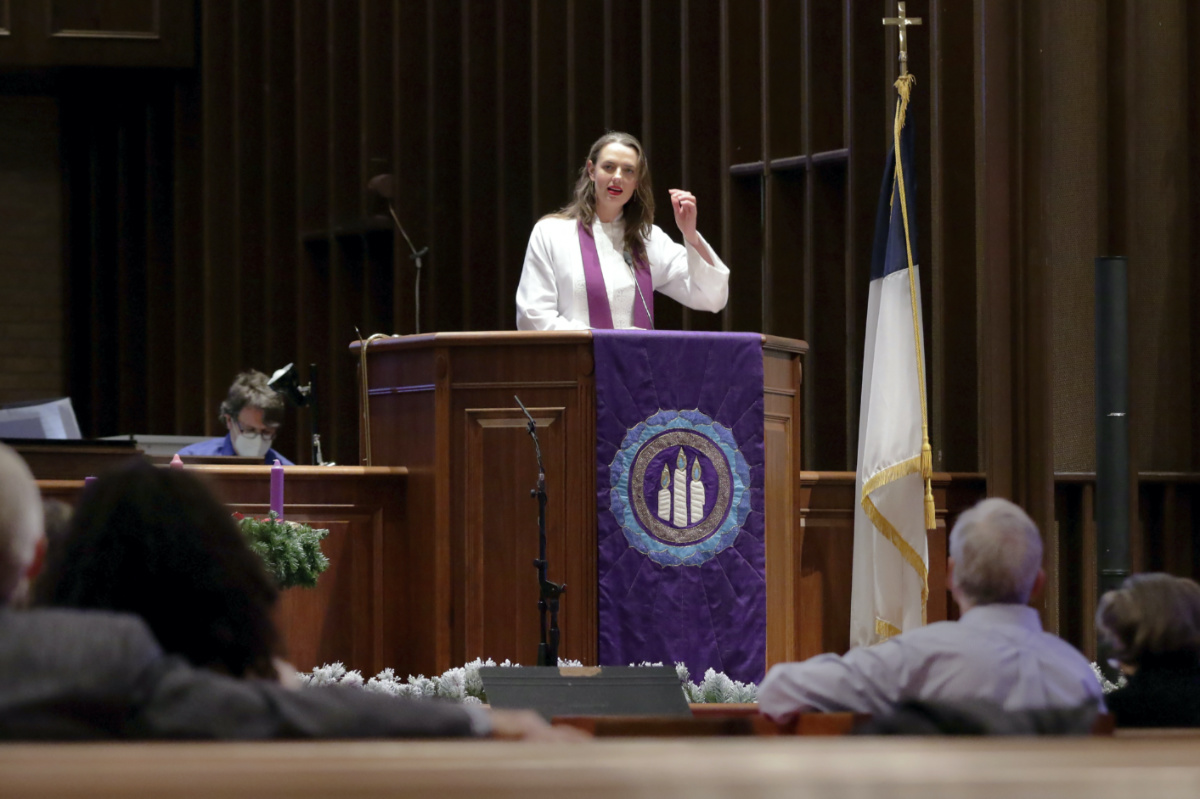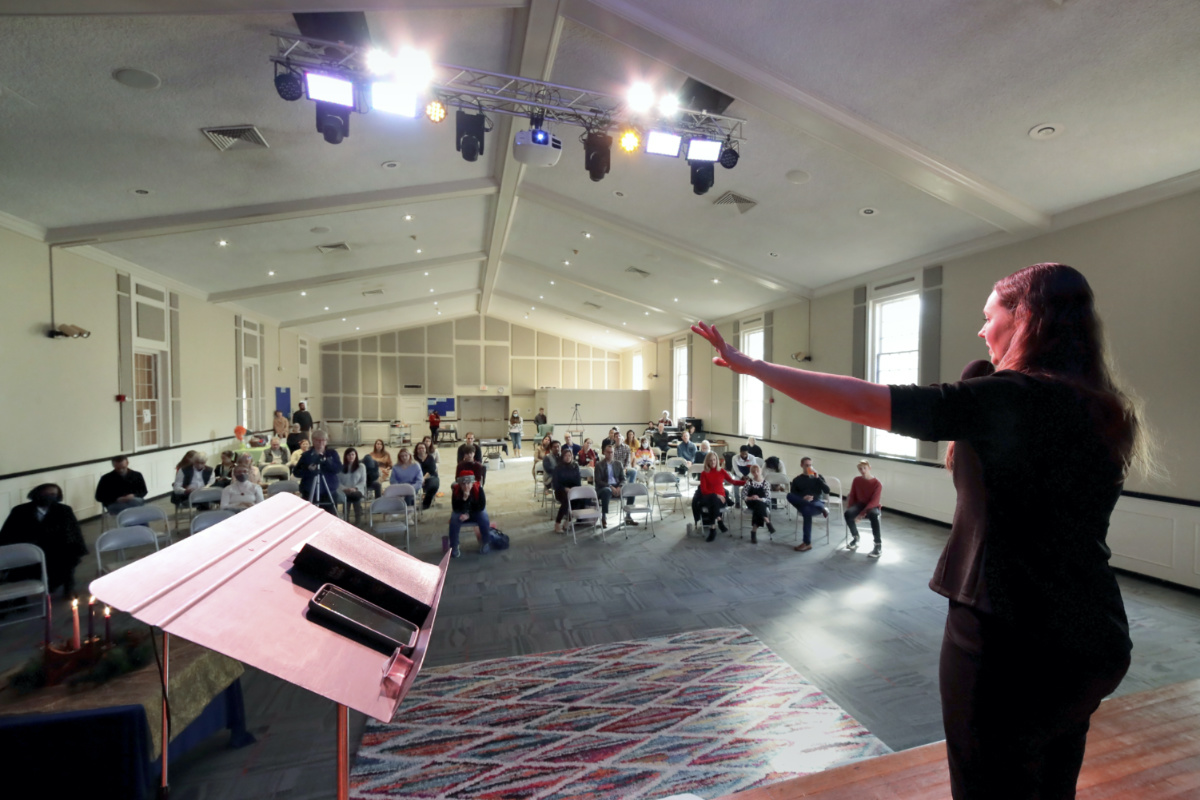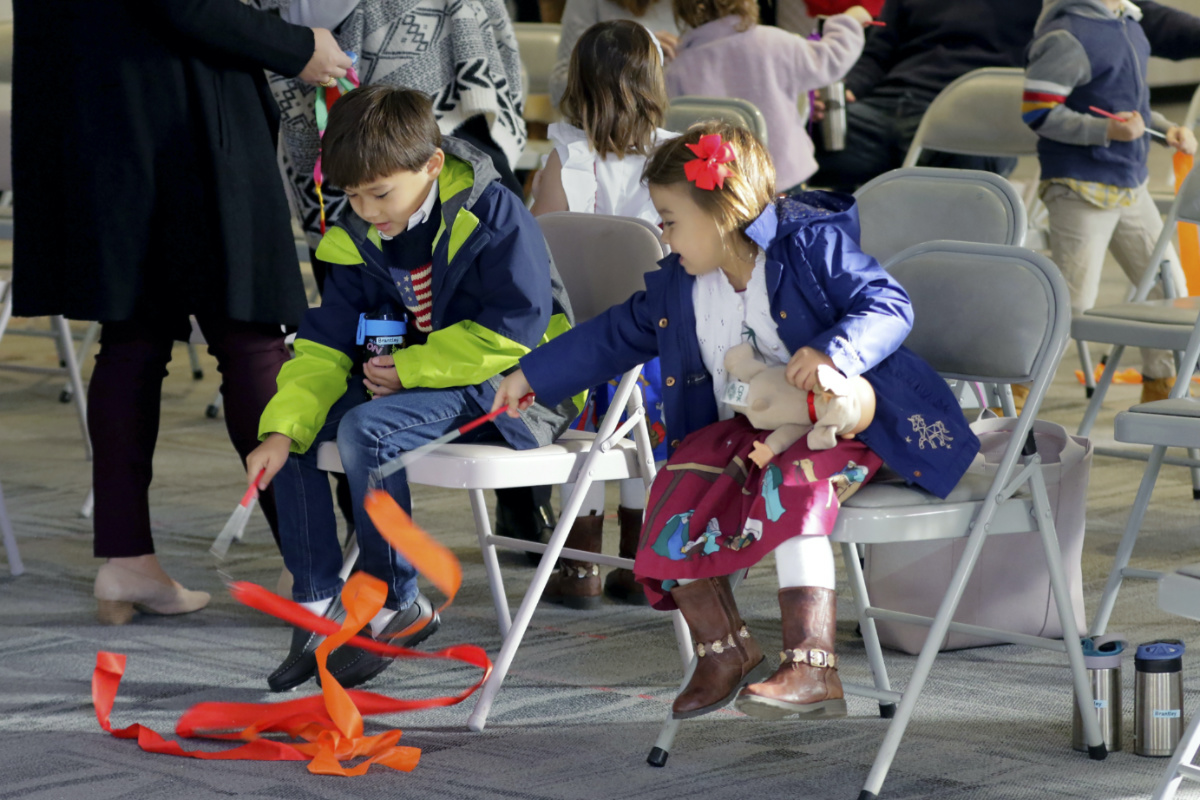
As churches and other houses of worship return to in-person services in the US, DAVID CRARY, of The Associated Press, reports on how congregations are responding…
When Westminster United Methodist Church in Houston resumed in-person services late last year, after a seven-month halt due to COVID-19, there were Sundays when only three worshippers showed up, according to the pastor, Meredith Mills.
Since then, attendance has inched back up, but it’s still only about half the pre-pandemic turnout of 160 or 170, Mills estimates.
“It’s frustrating,” she said. “People just seem to want to leave home less these days.”

Rev Meredith Mills delivers a sermon from the pulpit for some 30 attendants during the second service of the day in the sanctuary at Westminster United Methodist Church on Sunday, 12th December, 2021, in Houston. Attendance for the two Sunday services is only about half of the average pre-pandemic turnout of about 160 or 170, Mills says. “It’s better now than it was a year ago, but it’s still frustrating,” she said. “People just seem to want to leave home less these days.” PICTURE: AP Photo/Michael Wyke.
Some houses of worship are faring better than Mills’ church, some worse. Polls by The Associated Press-NORC Center for Public Affairs Research shows how dramatically church attendance fell during the worst of the pandemic last year, even as many say they are now returning to regular service attendance.
Among mainline Protestants, just one per cent said in a May, 2020, poll that they were attending in-person services at least once a week. In the new poll, 14 per cent say they’re doing so now, compared to 16 per cent who say they did in 2019.
“It’s frustrating. People just seem to want to leave home less these days.”
– Rev Meredith Mills of Westminster United Methodist Church in Houston.
Among evangelical Protestants, 37 per cent now say they are attending services in person at least weekly, while 42 per cent said they did that in 2019. In the May 2020 poll, just 11 per cent said they were attending services in person that often.
Among Catholics, 26 per cent attend in person at least weekly now, compared with 30 per cent in 2019. In the 2020 poll, conducted as many bishops temporarily waived the obligation for weekly Mass attendance, just five per cent were worshipping in person at least weekly.
At St Ambrose Catholic Parish in Brunswick, Ohio, the six services each weekend drew a total of about 3,800 worshippers before the pandemic, according to the pastor, Bob Stec. Current weekend attendance is about 2,800, Stec says, with 1,600 or more households joining online worship.
Elsewhere, churches large and small have taken hits in attendance.
John Elkins, teaching pastor at Sovereign Grace Fellowship in Brazoria, Texas, says 25 to 30 people have attended services recently, down from around 50 before the pandemic.
“For some, I was not political enough,” he said via email. “Some wanted more activities, some just stopped going to church.”
Sovereign Grace, a Southern Baptist church, had never offered online worship before the pandemic. When in-person worship was halted for a month in 2020, leaving online worship as the only option, Elkins said he did more crisis counseling for congregation members than ever before.

Rev Meredith Mills delivers a sermon from the pulpit during the second service of the day in the sanctuary at Westminster United Methodist Church, on Sunday, 12th December, 2021, in Houston. PICTURE: AP Photo/Michael Wyke.
At the much larger First Church of God in Columbus, Ohio, there was a near-total halt to in-person worship between March, 2020, and September of this year. On two Sundays in September 2020, worshippers were invited back to the church to test the feasibility of in-person services.
“But it was obvious they were still uncomfortable – they came dressed like they were working at Chernobyl,” said the senior pastor, Bishop Timothy Clarke, evoking hazmat suits appropriate for confronting a nuclear disaster.
Pre-pandemic, the predominantly African American church held three services each weekend, including one on Saturday evenings, with average total attendance of 2,500. Now there’s a single service on Sunday, and only 500 worshippers – with masks and proof of vaccination – are allowed into a sanctuary that can seat more than 1,500.
The return to in-person worship “gives us a sense of connection and community,” Clarke said. “But you also have safety.”
At All Saints’ Episcopal Church in the New York City borough of Brooklyn, average Sunday attendance dropped from about 140 pre-pandemic to as low as 30 before climbing back, reaching 120 earlier this month. Rev Steven Paulikas credits a mandatory mask policy.
“Mask wearing puts people at ease about their health and allows them to do what people come to church to do – worship God,” he said.
Attendance is down sharply from pre-pandemic levels at St Barnabas Lutheran Church in Cary, Illinois, which halted in-person, indoor worship for more than six months in 2020. Instead it held drive-in services in the parking lot.
Before the pandemic, about 115 people would attend one of two services offered on Sundays, said the pastor, Sarah Wilson. Now there’s one service, and attendance is down by more than half.
“Some families are still nervous about being in a room with others, even though most people attending are vaccinated and we require masks,” she said. “Other people have re-ordered their priorities and worship isn’t one of them.”

Rev Meredith Mills delivers a sermon to approximately 70 attendants as they sit in folding chairs during the first church service, held in the Fellowship Hall, at Westminster United Methodist Church on Sunday, 12th December, in Houston. The church holds two Sunday services. The first is a looser, more contemporary service with an electric band that is better attended by families with children. The second is the traditional service held in the sanctuary. PICTURE: AP Photo/Michael Wyke.
Friendswood United Methodist Church, in the Houston suburbs, has endured not only COVID-19 disruptions but also flooding during a winter storm last February that rendered the sanctuary unusable. It just reopened for services this month, said the pastor, Jim Bass.
Pre-pandemic, Friendswoods’ Sunday services would draw about 900 worshippers; Bass was pleased that about 650 gathered when the sanctuary reopened for high-energy, music-filled services on 5th December.
However, he said average attendance has been only half of that during most of the pandemic, creating a $US400,000 shortfall in expected giving.
Like many houses of worship, Friendswood offered online services as an alternative to in-person attendance. He considers them a mixed blessing – a plus for elderly congregation members worried about their health, but a disincentive for others who are increasingly disconnected from the church.
“They’ve become spectators,” Bass said.
We rely on our readers to fund Sight's work - become a financial supporter today!
For more information, head to our Subscriber's page.
At Temple Beth El in Charlotte, North Carolina, Rabbi Asher Knight was elated that recent Hannukah celebrations drew about 300 people in person. Overall, attendance now is roughly half of pre-pandemic levels, but an improvement over periods earlier this year when only a handful of worshippers appeared.
“It was demoralising and painful to lead worship with virtually no one present,” he said. “But in October and November, people got the booster and their children got vaccinated and they slowly started coming back.”
In September, amid a surge in COVID cases, Temple Judea in Coral Gables, Florida, observed the Jewish High Holy Days with no in-person services. So the sanctuary wouldn’t look so empty for online services, Rabbi Judith Siegal and her staff filled it with cardboard cutouts of congregation members, including children and pets.
In-person worship has now resumed, and the range of weekly attendance – 75 to 125 people – is close to pre-pandemic levels.
“We’re still wearing masks, and the seating is still spread out,” Siegal said. “But our members love it.”

Kids play with streamers during the first service, held in the Fellowship Hall at the Westminster United Methodist Church on Sunday, 12th December, 2021, in Houston. The church holds two Sunday services.PICTURE: AP Photo/Michael Wyke.
Among Christians, the option of worshipping online has been embraced by many evangelical Protestants, according to the AP-NORC poll. About three in 10 have livestreamed services at least weekly in recent months, compared with about one in 10 Catholics or mainline Protestants.
Three-quarters of evangelical Protestants say they pray privately at least weekly, compared with roughly half of mainline Protestants and Catholics, the poll found.
Roughly a quarter of evangelical Protestants say they’ve recently talked by phone or video conference with a religious or spiritual leader at least a few times a month, compared with about one in 10 mainline Protestants and Catholics.
Some faith leaders, such as Meredith Mills, see some positives, such as more energy in the church, even with fewer worshippers.
“The ones showing up right now are the people who really want to be there,” she said. “There’s a lot of joy in the room Sunday mornings. It’s one of the reasons that, despite everything, I still love my job.”
The AP-NORC poll of 1,083 adults was conducted between 21st and 25th October using a sample designed to be representative of US population. The margin of sampling error for all respondents is plus or minus four percentage points.





